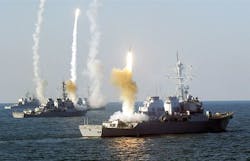Raytheon to network Navy tactical data links to coordinate electronic warfare (EW) and weapons
Officials of the Naval Air Warfare Center Aircraft Division in Lakehurst, N.J., announced an $11.8 million contract this week to the Raytheon Integrated Defense Systems segment in Tewksbury, Mass., for the Communications and Interoperability for Integrated Fires (CIIF) program.
The CIIF program seeks to develop networking and communications enhancements to enable next-generation sensor networking, electromagnetic maneuver warfare, and the integrated firing of naval weapons.
Electronic maneuver warfare involves electronic signals intelligence and electronic warfare (EW) jamming from Navy manned and unmanned aircraft, surface warships, and submarines, as well as coordinating electronic signals transmitted from aircraft, ships, and submarines to deceive or jam enemy use of the electromagnetic spectrum.
The Naval Air Warfare Center Aircraft Division is awarding the contract to Raytheon on behalf of the Office of Naval Research (ONR) in Arlington, Va., which is coordinating the project closely with the Naval Research Laboratory (NRL) in Washington.
Related: Navy reaches out to industry for new technologies to enhance shipboard sensor networking
The CIIF future naval capability program has two parts: communications-as-a-service (CaaS) to deliver data and information via any combination of available data links; and mission-based networking for data distribution systems (DDS MiND) to increase the throughput and scalability of the Navy's existing Cooperative Engagement Capability (CEC) program.
The existing Navy CEC is a real-time sensor network that combines sensor information from separate ships and aircraft to create a composite battlefield picture to enhance situational awareness -- particularly for anti-air warfare (AAW).
CaaS creates an on-demand network for integrated fires by combining naval tactical data links. The intent is not to translate data into different formats but to use CaaS devices on various platforms to expose the topology and performance of the various data links and encapsulate the data to deliver it to the next hop, naval researchers say.
Raytheon's primary challenge on the CaaS component is to deliver critical data to naval weapons and electronic warfare jammers within specified quality-of-service constraints like latency and jitter.
For this job Raytheon experts will focus on interfaces to various data links; ways to sense network latency, loss rates, and congestion on data links; allocating the right amount of network resources to ensure crucial information gets through in real time; deterministic networking to assure delivery of the highest priority data; and on reliable real-time interfaces between CaaS and naval weapons, EW jammers, and command and control.
Related: Navy orders networking radios for network-centric warfare from Rockwell Collins
For the DDS MiND component, Raytheon engineers will seek to the use of the CEC's data distribution system in support of non-CEC missions when CEC resources are available.
Raytheon's primary challenge for this job is to prevent any adverse impact on the core CEC mission while its data distribution system is performing these other functions.
Raytheon experts will focus on new waveforms and coding to improve throughput, reduce latency, and reduce losses; improving distributed resource allocation and scheduling algorithms for directional communications; ways to make legacy data systems interoperate with DDS MiND technology; network management and quality of service to handle non-CEC data; and new interfaces with the CaaS device.
Experts from Raytheon and the Navy will use a modeling and emulation environment to integrate components and assess the performance of prototype CaaS and DDS MiND technologies.
On this contract Raytheon will do the work in St. Petersburg and Largo, Fla.; El Segundo, Calif.; and Tewksbury, Mass., and should be finished by February 2020.
For more information contact Raytheon Integrated Defense Systems online at www.raytheon.com, the Naval Air Warfare Center Aircraft Division-Lakehurst at www.navair.navy.mil, the Office of Naval Research at www.onr.navy.mil, or the Naval Research Laboratory at www.nrl.navy.mil.
Learn more: search the Aerospace & Defense Buyer's Guide for companies, new products, press releases, and videos
